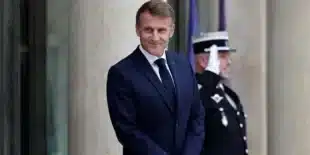Hamas conducted a public display on Saturday, parading three Israeli hostages before a gathered crowd in Gaza ahead of their official handover to the Red Cross. The three Israeli civilians were released in exchange for dozens of Palestinian detainees held by Israel as part of an ongoing ceasefire that has temporarily halted the conflict in Gaza.
Unlike previous prisoner exchanges, where captives were transferred without public statements, the three hostages were brought onto a stage, where a masked Hamas fighter held a microphone as they were made to address the crowd.
Meanwhile, a controversial proposal by former U.S. President Donald Trump to relocate the Palestinian population from Gaza has added further tension to negotiations. While Israel has welcomed the idea, Palestinians and most of the international community have firmly rejected it. Although the proposal has not yet impacted the current ceasefire phase, which is set to last until early March, it could complicate discussions for the next stage, in which Hamas is expected to release more hostages in exchange for a lasting ceasefire. The group may hesitate to free additional captives if it perceives that the U.S. and Israel are serious about depopulating Gaza, an act that human rights organizations argue would violate international law.
The hostages released on Saturday were identified as 52-year-old Eli Sharabi, 56-year-old Ohad Ben Ami, and 34-year-old Or Levy. They were among those taken captive during the Hamas-led attack on Israel on October 7, 2023, which triggered the war.
Ahead of the exchange, dozens of Hamas fighters, masked and heavily armed, assembled at a designated location near Gaza’s central north-south highway. Some arrived in white pickup trucks mounted with weapons. A small group of onlookers gathered nearby, though Hamas fighters formed a line to maintain distance from a temporary stage set up at the scene.
This marks the fifth prisoner exchange since the ceasefire took effect on January 19. So far, 18 Israeli hostages and over 550 Palestinian detainees have been freed under the agreement.
The first phase of the ceasefire includes provisions for the release of 33 Israeli hostages in exchange for nearly 2,000 Palestinian prisoners, the return of displaced Palestinians to northern Gaza, and an increase in humanitarian aid to the devastated region. Additionally, last week saw the first instance since May where injured Palestinians were permitted to leave Gaza for medical treatment in Egypt.
On Saturday, Israel released 183 Palestinian detainees, including 18 individuals serving life sentences for deadly attacks, 54 prisoners with long-term sentences, and 111 individuals from Gaza who were detained following the October 7 attack. The detainees, all men between the ages of 20 and 61, were viewed differently by both sides—while Israel considers them terrorists, many Palestinians regard them as fighters resisting Israeli occupation. Almost every Palestinian family has a relative, friend, or acquaintance who has spent time in Israeli prisons.
In a previous truce in November 2023, more than 100 Israeli hostages were freed in a weeklong ceasefire. However, more than 70 remain in Gaza. Israel estimates that 34 of them were either killed during the initial attack or died while in captivity. According to Israeli sources, Hamas has confirmed that eight of the 33 individuals set for release in the first phase of the ceasefire are deceased.
It remains unclear whether Israel and Hamas have entered negotiations for the second phase of the truce, which would involve the release of the remaining Israeli hostages and a potential extension of the ceasefire. If no agreement is reached, the war could resume in early March.
Despite the temporary pause in hostilities, Israel maintains its commitment to dismantling Hamas, even as the militant group quickly reasserted control over Gaza following the ceasefire. Within Israeli political circles, hardline figures, including members of Prime Minister Benjamin Netanyahu’s coalition, are calling for an immediate resumption of military operations once the first phase of the truce is completed.
Hamas, on the other hand, has made it clear that it will not release the remaining hostages without an end to the war and a complete Israeli withdrawal from Gaza.
The October 7 attack that set off the conflict resulted in the deaths of approximately 1,200 people in Israel, most of them civilians. Since then, Gaza’s Health Ministry reports that more than 47,000 Palestinians have been killed in Israel’s retaliatory air and ground operations, with over half of the casualties being women and children.
Among the 72 Palestinian detainees released on Saturday, five are from East Jerusalem, 14 from Gaza, and 53 from the occupied West Bank. Seven of them are expected to be transferred to Egypt ahead of further deportation.
In the West Bank, 47 prisoners were released from Ofer Prison and transferred to Palestinian custody at the Betunia crossing near Ramallah. Families, friends, and supporters had gathered there to celebrate their return, treating them as heroes.
Those freed had been imprisoned for a range of offenses, including involvement in militant activities and attacks spanning decades. One of the most notable figures among them is Iyad Abu Shakhdam, 49, who spent nearly 21 years behind bars for his role in Hamas-led attacks, including a 2004 suicide bombing on a bus in Beersheba that killed 16 people, including a four-year-old child.
Also released was Jamal al-Tawil, a high-profile Hamas politician from the occupied West Bank and former mayor of al-Bireh, near Ramallah. Over the past two decades, he has been repeatedly detained by Israeli authorities. His most recent arrest, in 2021, was linked to alleged involvement in violent riots and efforts to strengthen Hamas’ influence in the West Bank. He was placed under administrative detention, a system allowing suspects to be held for six months at a time without formal charges or trial.
The broader conflict traces back to Israel’s capture of the West Bank, Gaza, and East Jerusalem during the 1967 Mideast war. Palestinians seek all three territories as part of their future independent state.


